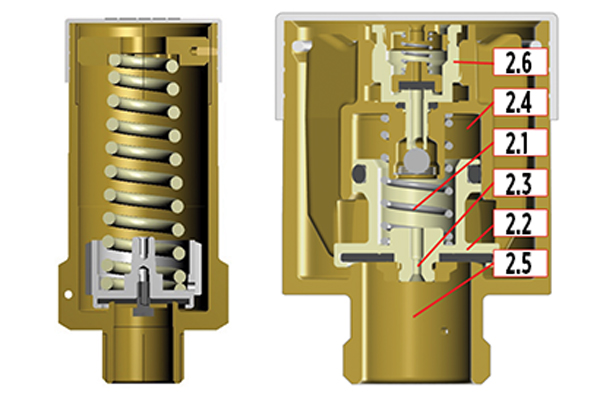Renewing relief valves safely
In my last column, I addressed how propane containers play a key role in safe system operation. Today, I will expand on safety relief valve operation and, in particular, external relief valves, commonly known as spring-loaded pressure relief valves, pop-off valves, pressure-venting valves or, simply, relief valves.
The operating principle that provides safety protection to the container is based on discharging excess pressure to the atmosphere until the container pressure drops and then the relief valve closes. But how does it do this?
Traditional pressure relief valves, shown in Figure 1, are valves based on the compression of a spring, which forces the valve into a closed position. If the pressure rises above that of the pressure of the spring, the valve opens. Once the pressure is released and the container pressure falls below that of the spring, the valve closes.
Pressure relief valves with a replaceable cartridge have been developed so that propane marketers no longer need to evacuate and depressurize the container to renew the relief valve. This cartridge-style relief valve has safety and operational advantages.
The design allows the user to replace the cartridge while the main body of the valve remains installed and the container remains pressurized. It also reduces the strain on the internal seals of the valve.
Cartridge-style relief valves
The cartridge-style valve, illustrated in Figure 2, assures a balanced distribution of force exerted by the inner pressure of the container, avoiding the use of a contrast spring with considerable load.
The load of the spring (2.1) is about 10 times lower than the load of the springs used on standard valves since it has only a “return-to-closed-position” action for the main piston (2.2).
The condition of essential equilibrium of forces, produced by the pressure inside the container, is achieved by means of the small hole (2.3) that connects the sliding chamber (2.4) of the main piston with the lower part of the orifice (2.5) and, therefore, with the internal side of the container.
To assure a prevailing force when closing, the chamber diameter (2.4) is slightly larger than the diameter of the orifice (2.5).
The opening pressure of the piston (2.2) and the valve discharging pressure are determined by a small-size valve (2.6), which, when activated, lowers the pressure inside the chamber (2.4) and opens the main piston (2.2).
When the container pressure reaches the reseat value for the main valve, the valve (2.6) closes and a pressure equalizes inside the chamber (2.4), which closes the main piston (2.2).
Safety advantages
The safety advantage of the cartridge-style relief valve is being able to renew the safety relief valve by simply replacing the cartridge. We all know that evacuating and depressurizing a large container takes a special skill set, which typically involves flaring. This process can take hours to days to complete with the constant risk that something will go wrong. Renewing the valve quickly, without evacuation or depressurizing the container, provides a safer and environmentally friendly approach to renewing safety relief valves. Cost reductions are evident, as well.
This innovation in relief valves provides a reliable, efficient and safe means to maintain containers with renewed pressure relief valves.
Randy Warner is the product safety manager for Cavagna North America. He can be reached at randywarner@us.cavagnagroup.com.
NOTE: The opinions and viewpoints expressed herein are solely the author’s and should in no way be interpreted as those of LP Gas magazine or any of its staff members.

















